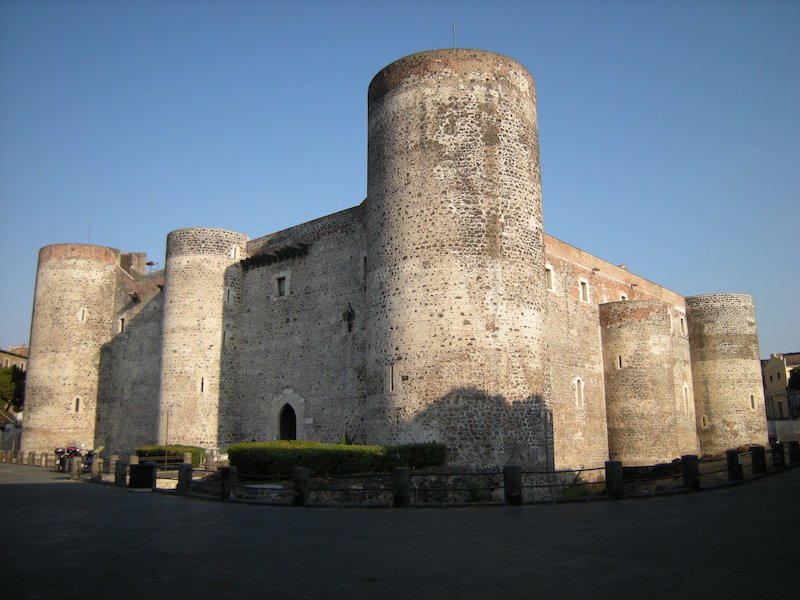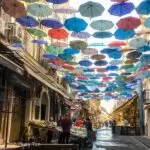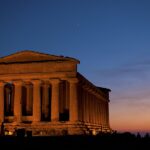Estimated Reading Time: 8 minutes
Sicily isn’t just an island – it’s a world waiting to be explored. I’ve been wandering this incredible corner of the Mediterranean for years, and I’m constantly amazed by how much you can pack into a single day. From ancient Greek theaters with Mount Etna as your backdrop to baroque towns that look like movie sets, Sicily serves up experiences that’ll leave you planning your next trip before the current one ends.
The beauty of Sicily lies in its diversity. You can start your morning exploring 2,500-year-old temples, lunch on fresh seafood in a fishing village, and end your day sipping wine made from grapes grown in volcanic soil. And the best part? It’s all doable as day trips, thanks to improved transportation and some insider knowledge I’m excited to share.
Why Sicily Day Trips Are Pure Magic
Let me paint you a picture. Last spring, I watched the sunrise over ancient Greek columns in Agrigento, had lunch with a local family in their courtyard in Noto, and ended the day watching Mount Etna glow against the twilight sky from Taormina. All in one day. This is what Sicily offers—layers of history, culture, and natural beauty so dense that every turn reveals something extraordinary.
The island’s geography works in your favor. Sicily’s roughly triangular shape means that from any major city, you’re rarely more than two hours from something spectacular. Plus, recent improvements to train connections and bus services have made getting around easier than ever. A day trip here isn’t just about ticking boxes—it’s about immersing yourself in stories that span millennia.
1. Taormina: Where Ancient Meets Stunning
Perched dramatically on a cliff overlooking the Ionian Sea, Taormina feels like the gods themselves designed it. The star attraction is the Ancient Theatre, originally built by the Greeks in the 3rd century BC. But here’s what makes it special—it’s the views. When you’re sitting in those ancient stone seats, you’re looking out at Mount Etna on one side and the sparkling Mediterranean on the other.
Getting There & Costs
- Train from Catania: 1 hour, €4.50
- From Palermo: 3 hours with one change, €13.20
- Theater entrance: €10 (€5 for EU citizens under 26)
- Best visiting hours: Early morning (8:30 am) or late afternoon (after 5 pm)
Walk down Corso Umberto I, the pedestrian main street that’s been the heart of the town for centuries. Yes, it’s touristy, but there’s a reason for that—it’s gorgeous. Stop at Caffè Wunderbar for an aperitivo with a view, or duck into one of the side streets where locals still hang their laundry from medieval balconies.
Don’t miss Isola Bella, the tiny island connected to the mainland by a narrow strip of beach. The water here is crystal clear, and it’s perfect for a quick swim if you’re visiting in summer. Pro tip: bring water shoes—the beach is pebbly.
Insider Secret: Visit the public gardens (Giardini della Villa Comunale) at sunset. They’re free, less crowded than the theater, and offer equally stunning views.
2. Mount Etna: Europe’s Most Active Volcano
Standing on Mount Etna is like visiting another planet. The landscape shifts from lush green vineyards to black volcanic rock to something that looks like the surface of Mars. At 3,329 meters tall, Etna dominates eastern Sicily’s skyline, and she’s been putting on a show for thousands of years.
The Reality Check
Let’s be honest about costs here—Etna isn’t cheap if you want the full experience. The cable car to 2,500m costs €50 for adults, and if you want to go higher to the summit craters with a guide, you’re looking at €78-120 more. But here’s the thing—it’s worth every euro.
Budget-Friendly Alternative
Take the AST bus from Catania to Rifugio Sapienza for just €6.60 return. You can explore the lower craters, walk around the visitor center, and still get incredible views without breaking the bank. The landscape here is fascinating—you can see different lava flows from different eruptions.
What to Expect
Even in summer, bring warm clothes. I learned this the hard way on my first visit, shivering in shorts and a t-shirt while the wind whipped across the volcanic slopes. Temperatures can drop 20°C as you gain elevation. Also, if you have asthma or heart conditions, stick to the lower elevations—the high-altitude tours aren’t recommended.
Wine Country Bonus
The volcanic soil around Etna produces some of Sicily’s best wines. Stop at a vineyard like Planeta or Benanti on your way back down. The contrast between the harsh volcanic landscape and the elegant wines it produces is remarkable.
3. Palermo: A Cultural Feast for Your Senses
Palermo hits you like a wave—chaotic, colorful, and intoxicating. This is Sicily’s capital, and it wears its 3,000-year history on its sleeve. Arab, Norman, and Spanish influences blend into something uniquely Sicilian, and nowhere is this more evident than in the architecture and food.
Must-See Highlights
Start at the Palermo Cathedral, a stunning example of what happens when different cultures build on the same site for centuries. The exterior shows Norman, Gothic, and Neoclassical elements, while inside you’ll find Arab geometric patterns alongside Christian mosaics.
The Quattro Canti is Instagram-famous for a reason – this baroque intersection creates a perfect cross in the old city center. Each corner represents a season, a Spanish king, and a patron saint of Palermo.
The Food Scene
Forget the guidebook restaurants for lunch. Head to Mercato di Ballarò, Palermo’s oldest market. Here you can try authentic street food for €1-2 per item. Get the panelle (chickpea fritters), arancine (rice balls – yes, they’re feminine in Palermo), and sfincione (Sicilian pizza). The vendors are characters, and the atmosphere is electric.
Getting Around
Palermo’s city center is walkable, but use public transport for longer distances. A day ticket costs €3.50 and includes buses and the new tram line. Avoid driving in the historical center – the traffic is legendary, and not in a good way.
Cultural Note
In Palermo, take time to appreciate the chaos. This isn’t about efficiency – it’s about passion, family, and living life fully. Embrace the noise, the gesturing, and the general sense that anything could happen.
4. Agrigento and the Valley of the Temples
If you see one archaeological site in Sicily, make it this one. The Valley of the Temples isn’t actually in a valley (it’s on a ridge), but who cares when you’re standing in front of the best-preserved Greek temples outside of Greece itself?
The Temple Experience
The site is huge – 240 hectares of ancient ruins dating back to the 5th century BC. The Temple of Concordia is the star, so well-preserved you can almost imagine ancient Greeks gathering here. The Temple of Juno offers the best views, especially at sunset when the golden limestone seems to glow.
Practical Planning
- Entrance fee: €16 (€6 for EU citizens 18-25, free under 18)
- Opening hours: 8:30am-7pm (summer), 8:30am-5pm (winter)
- Plan for 3-4 hours minimum
- Bring water, sun protection, and comfortable shoes
Beat the Crowds
First Sunday of each month is free, but you’ll be competing with half of Sicily for space. Instead, arrive right at opening time or visit during the late afternoon golden hour. The light on the temples at sunset is magical, and you’ll have space to actually appreciate what you’re seeing.
Archaeological Museum
Don’t skip this—it houses the Telamon, a giant stone figure that once supported the Temple of Zeus. At 7.5 meters tall, it gives you a sense of just how massive these temples once were.
5. Cefalù: The Perfect Seaside Escape
Cefalù is what happens when you combine a beautiful beach with a UNESCO World Heritage medieval town. It’s about an hour from Palermo, making it perfect for a day trip that combines culture with some serious beach time.
The Cathedral
The Norman Cathedral dominates the town with its fortress-like towers. Inside, the Christ Pantocrator mosaic is considered one of the finest examples of Byzantine art in existence. The golden background seems to shimmer, and the eyes follow you wherever you stand.
Beach Life
The main beach stretches right in front of the old town, making it easy to alternate between cultural exploration and seaside relaxation. The water is incredibly clear, and there are beach clubs if you want amenities or free areas if you prefer to bring your own gear.
La Rocca
For the more adventurous, hike up La Rocca (the rock) that towers over the town. It’s about a 30-minute climb, but the 360-degree views of the coast and town below are spectacular. Go early morning or late afternoon to avoid the heat.
Dining Tip: Skip the touristy restaurants on the main square. Walk two blocks inland to find family-run trattorias where locals actually eat. The fish is incredibly fresh, and portions are generous.
6. Noto: Baroque Architecture at Its Finest
Noto is Sicily’s baroque masterpiece, rebuilt entirely in the early 18th century after a devastating earthquake. The result is a harmonious townscape that looks like a movie set—in fact, it has been one for several films.
The Cathedral
Noto’s Cathedral, rebuilt after the original collapsed in 1996 (don’t worry, the current one is reinforced), sits at the top of a dramatic staircase. The honey-colored limestone changes color throughout the day, from pale gold in the morning to deep amber at sunset.
Walking the Town
The main street, Corso Vittorio Emanuele, is a UNESCO-protected thoroughfare lined with palaces and churches. Take your time—this isn’t about rushing from sight to sight. It’s about appreciating how an entire town can be a work of art.
Photography Gold
Every corner in Noto is photogenic, but for the ultimate shot, climb the bell tower of Chiesa di San Carlo for panoramic views over the baroque rooftops.
Sweet Treats
Try cannoli at Caffè Sicilia, which has been making them since 1892. The ricotta filling is made fresh daily, and the shells are crisp perfection. It’s been featured in food documentaries worldwide for good reason.
7. Syracuse: Where History Comes Alive
Syracuse was once more powerful than Athens, and walking through the archaeological park, you can feel that ancient grandeur. This isn’t just about old stones—it’s about standing where Archimedes made his discoveries and Plato taught philosophy.
Neapolis Archaeological Park
The Greek Theater is the main attraction, still used for performances during the summer festival. The acoustics are so perfect that a whisper from the stage can be heard in the top rows. The Roman Amphitheater shows how the Romans adapted Greek designs for their own brutal entertainments.
The Ear of Dionysius, a limestone cave with incredible acoustics, gets its name from its shape and the legend that the tyrant Dionysius used it to eavesdrop on prisoners.
Ortigia Island
Connected to the mainland by bridges, Ortigia is Syracuse’s historic heart. The Cathedral is built into a Greek temple—you can still see the ancient columns incorporated into the Christian structure. It’s a perfect metaphor for Sicily itself: layers of history built one on top of another.
Local Life
Visit the morning market in Ortigia for fresh seafood and produce. The vendors are friendly, and you’ll see how locals really shop and eat. Try the local specialty, bottarga (cured fish roe), shaved over pasta.
Hidden Gems Worth the Extra Effort
The Southeastern Baroque Triangle: Modica, Ragusa, and Scicli
These three UNESCO towns offer baroque beauty without Noto’s crowds. Modica is famous for its ancient chocolate-making tradition (try Bonajuto for chocolate made using 16th-century Aztec methods). Ragusa splits into upper and lower towns connected by scenic stairs, while Scicli served as the fictional Vigàta in the Inspector Montalbano TV series.
Villa Romana del Casale, Piazza Armerina
Home to the world’s finest Roman mosaics, including the famous “Bikini Girls” depicting female athletes. The villa shows how wealthy Romans really lived, with underfloor heating and elaborate decoration in every room.
Segesta
A perfectly preserved Greek temple in a stunning hillside setting, plus a theater with panoramic views. Less crowded than Agrigento but equally impressive, and the journey through the Sicilian countryside is beautiful.
The Aeolian Islands (Day Trip from Milazzo)
New regulations in 2024 restrict Stromboli access, but boat tours around the island offer spectacular volcano viewing, especially the evening tours when you can see the lava flows against the dark sky. Vulcano still allows hiking to the crater rim for €5.
Salt Pans of Trapani
Otherworldly landscapes where traditional salt harvesting continues. The pink hues at sunset, windmills, and flamingo sightings create an ethereal atmosphere. The drive along Via del Sale is spectacular.
Planning Your Perfect Day Trip
Transportation Reality Check
By Train:
- Catania to Taormina: 1 hour, €4.50
- Palermo to Cefalù: 1 hour, €5.90
- Syracuse to Noto: 30 minutes, €3.60
Note: The main Palermo-Catania rail line requires bus replacement until 2025 due to modernization work.
By Car: Rental costs range from €25-30 per day for economy cars, plus €1.70/liter for fuel. Parking at major attractions costs around €3.50. Avoid city centers in Palermo and Catania due to restricted traffic zones (ZTL).
By Bus: AST buses are economical and reach places trains don’t. Mount Etna from Catania costs just €6.60 return, while intercity SAIS buses run €10-15 between major destinations.
Budget Guidelines
Budget Day Trip: €59-70 per person
- Transportation: €10-15
- Attraction entries: €15-20
- Meals: €25-30
- Miscellaneous: €10
Mid-Range Day Trip: €123-140 per person
- Private transport or guided tours: €40-60
- Premium attraction access: €30-40
- Restaurant dining: €50-60
- Souvenirs and extras: €20
Luxury Day Trip: €260-292 per person
- Private driver or premium tours: €120-150
- Exclusive experiences: €60-80
- Fine dining: €80-100
- Premium shopping: €40-60
Seasonal Considerations
Spring (March-May): Wildflowers, fewer crowds, variable weather. Pack layers and an umbrella.
Summer (June-August): Perfect beach weather, maximum crowds, hot temperatures (25-30°C). Book accommodations and tours in advance.
Autumn (September-November): Warm seas, harvest season, ideal temperatures. Best overall weather for sightseeing.
Winter (December-February): Lowest prices, cultural focus, shorter days. Cool and wet, but perfect for museums and indoor attractions.
Essential Apps and Tools
- Trenitalia: For train tickets and real-time schedules
- Google Maps: Download offline maps for your areas
- FreeNow: Taxi booking in Palermo and Catania
- EasyPark: Digital parking payments
- Sicily Travel Guide: Read my free and comprehensive guide to Sicily!
Cultural Etiquette
Sicily isn’t mainland Italy—it has its own distinct culture and pride. Learn a few basic phrases: “Buongiorno” (good morning), “Grazie” (thank you), “Quanto costa?” (How much?). Sicilians appreciate the effort, even if your pronunciation is terrible.
Dress modestly for churches (shoulders and knees covered), and remember that lunch happens between 12:30-2:30 pm, dinner after 7:30 pm. Many shops close for riposo (afternoon rest) from 1-4 pm.
Frequently Asked Questions
How many destinations can I realistically visit in one day?
Stick to one main destination plus maybe a quick stop en route. Sicily rewards slow travel – rushing between multiple major sites means you’ll miss the authentic experiences that make each place special.
Is it safe to drive in Sicily?
Yes, but be prepared for aggressive driving styles and confusing signage. Avoid city centers where restricted traffic zones can result in expensive fines. Stick to main highways between cities.
What should I pack for Mount Etna?
Regardless of the season, bring warm layers, sturdy shoes, and wind protection. Temperatures drop significantly with elevation, and weather can change quickly. Sunglasses and sunscreen are essential due to the reflection off volcanic rock.
How much should I budget for food?
Street food: €1-2 per item. Casual dining: €15-25 per person. Mid-range restaurants: €35-45 per person. Fine dining: €60+ per person. Don’t miss the markets for authentic, affordable experiences.
Do I need to book attractions in advance?
For Mount Etna summit tours, yes—especially in summer. For most other attractions, advance booking isn’t necessary but can save time during peak season. Some sites offer online discounts.
What’s the best base for day trips?
Catania offers the best transportation connections and proximity to Mount Etna and eastern attractions. Palermo works well for western Sicily and the Aeolian Islands. Syracuse is perfect for exploring the southeastern baroque towns.
How touristy is Sicily compared to mainland Italy?
Less touristy overall, especially outside the main attractions. You’ll find authentic local life continues alongside tourism, and prices remain reasonable compared to Florence or the Amalfi Coast.
What about language barriers?
Basic Italian helps, but don’t worry if you don’t speak it. Sicilians are incredibly warm and patient with visitors. In tourist areas, English is widely spoken. Learning “please,” “thank you,” and “excuse me” in Italian goes a long way.
Final Thoughts
Sicily isn’t just a destination—it’s a revelation. Every day trip here tells a story that spans millennia, from Greek colonists to Arab scholars to Norman knights to modern Sicilians who’ve inherited this incredible cultural legacy. The beauty lies not just in the ancient temples or baroque churches, but in how they coexist with contemporary life.
I’ve seen visitors arrive planning to check off the “must-see” sites and leave completely transformed by unexpected encounters: a conversation with a fisherman in Syracuse, a spontaneous invitation to a family lunch in Noto, watching teenagers cliff-dive into crystalline waters while ancient temples watch from above.
The key to Sicily is remaining open to these moments. Yes, plan your logistics—book your Mount Etna tour, check train schedules, and make dinner reservations. But leave room for serendipity. This is an island where the best experiences often happen when you’re least expecting them.
Sicily rewards the curious, the patient, and the respectful. Approach it with open eyes and an open heart, and you’ll discover why so many travelers consider it not just a destination, but a love affair that lasts a lifetime.
Plan your trip to Sicily today, and prepare to be amazed!





